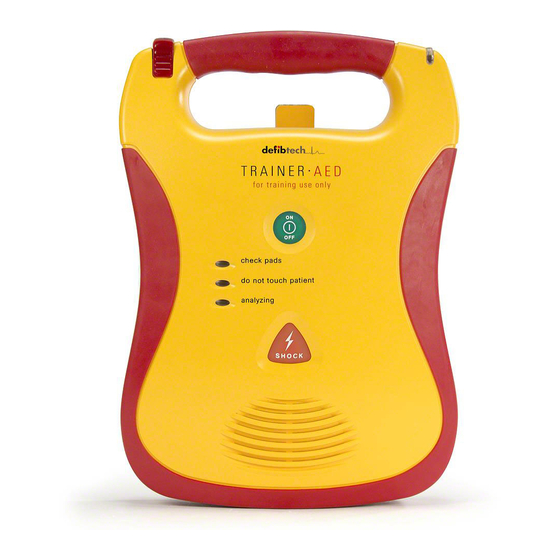Summary of Contents for Defibtech Standalone AED Trainer
-
Page 1: User Manual
AED Training Equipment - Standalone AED Trainer - Training Battery Pack System User Manual Training Software V2.2 DAC-515E Rev. C... -
Page 2: Limited Warranty
Notices Defibtech shall not be liable for errors contained herein or for incidental or consequential damages in connection with the furnishing, performance, or use of this material. Information in this document is subject to change without notice. Names and data used in the examples are fictitious unless otherwise noted. -
Page 3: Table Of Contents
2.1.3 Training Pads ................2 2.2 Standalone AED Trainer ............3 2.3 Training Battery Pack System ..........3 2.3.1 Configuring a Defibtech DDU-100 series AED as a Trainer ....3 3 Training Scenarios ................. 4 3.1 Available Scenarios ..............4 3.2 The Default Training Scenario.......... -
Page 4: Introduction To Defibtech Aed Training Products
1 Introduction to Defibtech AED Training Products Defibtech offers two equipment options for training students in the use of its AEDs: The “Standalone AED Trainer” is a dedicated training AED package that is externally similar to a fully-functional Defibtech AED, but has bright red overmolding to clearly distinguish it as a training device. -
Page 5: Training Equipment Components & Preparation
2 Training Equipment Components & Preparation Note: The following section 2.1 applies to both the Standalone AED Trainer and the Training Battery Pack System. After reviewing this section, please refer to either section 2.2 or section 2.3 as appropriate to your specific training equipment. -
Page 6: Standalone Aed Trainer
2.2 Standalone AED Trainer WARNING: The Standalone AED Trainer cannot be used to defibrillate patients. The components required to operate the Standalone AED Trainer are: Standalone AED Trainer (DDU-100TR series). Training Battery Pack (DBP-RCX series) - supplied with the Standalone AED Trainer. -
Page 7: Training Scenarios
3 Training Scenarios 3.1 Available Scenarios Six training scenarios (described below) are available for training exercises, and can be changed during training as desired. The following scenarios are available: VF (Ventricular Fibrillation) that converts to a non-shockable rhythm (normal sinus rhythm) after the 1st shock. This scenario is based on the American Heart Association AED training scenario and allows for a quick overview and demonstration of AED operation. -
Page 8: Programming The Default Scenario
Default Scenario is reprogrammed. 3.3.2 Programming the Default Scenario With the Remote Control Note: When performing training using the Remote Control, Defibtech recommends programming training scenario #6 (Pads not applied) as the Default Training Scenario. This will allow the instructor to manually select rhythm simulations or other training scenarios as desired using the Remote Control. -
Page 9: Remote Control Commands
4 Remote Control Commands The Remote Control can be used to change the behavior of the AED at any time while the unit is powered on. The remote will have no effect on an AED not configured as a trainer. The following functions can be performed using the Remote Control keys: •... -
Page 10: Using The Remote Control With Multiple Aeds
5 Using the Remote Control With Multiple AEDs The Remote Control can be used to individually control up to four AEDs at a time in a classroom setting. To control each of the four AEDs individually, each AED must be assigned a unique letter “name. -
Page 11: Notice To European Union Customers
6 Notice to European Union Customers The crossed-out wheeled bin symbol on this device indicates that this equipment has been put on the market after 13 August 2005, and is included in the scope of the directive 2002/96/EEC on waste electrical and electronic equipment (WEEE) and of the national decree(s) which transpose provisions of such directive. -
Page 12: Contacts
Tel.: (866) 333-4241 (Toll-free within North America) (203) 453-4507 Fax : (203) 453-6657 Emails: sales@defibtech.com (Sales) reporting@defibtech.com (Medical Device Reporting) service@defibtech.com (Service and Repair) European Authorized Representative: Emergo Europe Molenstraat 15 2513 BH The Hague The Netherlands Tel.: +31 70 345 8570...

















Need help?
Do you have a question about the Standalone AED Trainer and is the answer not in the manual?
Questions and answers